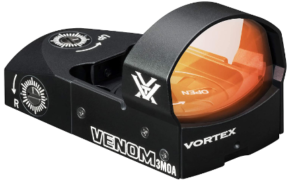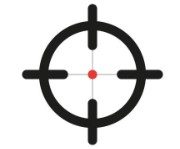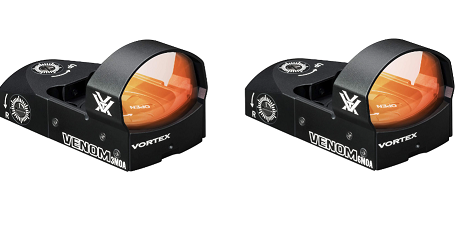Are you wondering what the difference is between 3 MOA and 6 MOA reticles? In this 3 MOA vs 6 MOA red dot comparison, you will learn what MOA (Minute of Angle) is. We will also share the pros and cons of each red dot reticle to help you make a well-informed purchase.
Red dot sights are designed to project a red dot onto the lens, which helps to improve precision and accuracy. The size of the red dot is measured in minutes of angle (MOA).
A 3 MOA dot is smaller and more precise than a 6 MOA dot, which is larger and easier to see. 3 MOA red dots are ideal for long-range shooting applications. On the other hand, 6 MOA red dots are suitable for close-range shooting applications.
The choice between the two reticles will depend on your shooting preference and intended firearm use. Therefore, it is advisable to define your requirements first, to make the selection process manageable.
What is MOA?
Minutes of angle (MOA) is a unit of measurement used to measure the reticle size. This measurement is used to describe the angle of a shot. It is one of the best ways to measure the accuracy of your firearm.
Minute of Angle (MOA) is a unit of measurement used in the field of firearms, representing an angle that spans approximately one inch in diameter at a distance of 100 yards.
The size of the red dot, measured in MOA, represents the area where you can expect your rounds to hit when target shooting. At 100 yards, a 3 MOA red dot will appear as a 3-inch circle on the target, while a 6 MOA red dot will appear as a 6-inch circle on the target.
Let us learn more about 3 MOA and 6 MOA red dot sights.
3 MOA Red Dot
 3 MOA red dots are more precise, as they cover less target area. This dot will cover an area of about 3 inches at 100 yards and about 6 inches at 200 yards.
3 MOA red dots are more precise, as they cover less target area. This dot will cover an area of about 3 inches at 100 yards and about 6 inches at 200 yards.
They are popular because you can use them at varying distances. We recommend them for shooters who want to strike a balance between precision and speed.
The only downside of 3 MOA red dots is that the dot may not be very visible, especially in low or bright sunlight conditions.
However, these red dots are suitable for long-range precision shooting, target shooting, hunting, and competitive shooting. They are also compatible with many firearms available today. Let us look at the pros and cons of 3 MOA red dots.
Pros
- 3 MOA red dots are more precise compared to 6 MOA red dots.
- They are suitable for long-range shooting.
- They are suitable for target shooting, hunting, and competitive shooting.
- They are designed for shooting applications that require fast target acquisition.
- There are some options designed for low-light performance.
- They are built with durable materials to withstand recoil and impact.
- They are compatible with many firearms.
Cons
- The dot is harder to see, especially when aiming at long-range targets.
- They are relatively more expensive than 6 MOA red dots.
- They have a limited field of view.
6 MOA Red Dot
 A 6 MOA red dot covers an area of about 6 inches at 100 yards and about 12 inches at 200 yards. These red dots are considered to be less precise when compared to 3 MOA red dots. However, they are easier to see when aiming targets at longer ranges or low-light conditions.
A 6 MOA red dot covers an area of about 6 inches at 100 yards and about 12 inches at 200 yards. These red dots are considered to be less precise when compared to 3 MOA red dots. However, they are easier to see when aiming targets at longer ranges or low-light conditions.
6 MOA red dots are suitable for close-range shooting, hunting, and self-defense. This is why they are mainly used for tactical shooting, as the larger dot allows for faster target acquisition.
We recommend 6 MOA red dots for shooters who want a sight that strikes a good balance between precision and quick target acquisition. In addition, if you have astigmatism, a 6 MOA red dot is the best sight for you.
The downside of these red dots is that they are challenging to use when engaging long-range targets.
Let us look at the pros and cons.
Pros
- The large size of 6 MOA red dots makes them ideal for close-range shooting applications.
- They offer more visibility, especially in low-lighting conditions.
- They are ideal for self-defense and tactical shooting.
- They are designed to be shock-resistant, making them suitable for rough use.
- They are compatible with many firearms.
- They are cost-effective compared to 3 MOA red dots.
Cons
- They are not suitable for long-range shooting.
- They have a limited field of view.
- They are less precise compared to 3 MOA red dots.
Frequently Asked Questions on 3 MOA Vs 6 MOA Red Dot
- What is the difference between a 3 MOA and a 6 MOA red dot?
The main difference between a 3 MOA and a 6 MOA red dot is the size of the red dot projected onto the glass window. A 3 MOA red dot is smaller and more precise, while a 6 MOA red dot is larger and easier to see. We recommend 3 MOA red dots for long-range shooting and 6 for close-range shooting.
- How do I choose between a 3 MOA and a 6 MOA red dot?
When choosing between a 3 MOA and a 6 MOA red dot, it is always important to consider the intended use of the firearm. It is also essential to consider your personal preferences. If you plan to use the gun for long-range shooting, a 3 MOA dot is a better solution because of its precision. If you plan to use the firearm for close-range shooting or hunting, a 6 MOA dot is a solid choice for its ease of acquisition.
- Can a 3 MOA red dot be used for hunting?
Yes, a 3 MOA red dot can be used for long-range hunting. However, using a scope with variable magnification is advisable, allowing you to use your firearm effectively at different ranges.
- Are 3 MOA and 6 MOA red dot water-resistant?
Many red dots are built with durable materials and are water and shock-resistant. However, it’s essential to check the product specifications before purchasing. This will ensure you pick a red dot sight with the desired level of water resistance. However, these sights are more expensive than the regular ones.
- Is a 3 MOA red dot suitable for self-defense?
A 3 MOA red dot can be used for self-defense. However, a 6 MOA red dot is better for self-defense due to its larger size and faster target acquisition.
Conclusion
By now, we are sure you know the difference between 3 MOA and 6 MOA red dots. Each reticle has its own pros and cons.
It’s important to note that a 6 MOA dot is less precise than a smaller one. It also covers more than the target, which makes it difficult to aim at smaller targets. Therefore it’s important to choose the right size of the dot based on the intended use and personal preference.
3 MOA and 6 MOA red dots are very easy to use, and we recommend them for beginners. It’s important to try different sizes and types of red dots before making a final decision.
You can also check Red Dot Vs Holographic.

